Related Research Articles
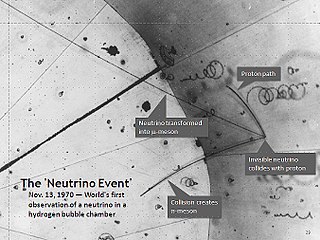
A neutrino is a fermion that interacts only via the weak interaction and gravity. The neutrino is so named because it is electrically neutral and because its rest mass is so small (-ino) that it was long thought to be zero. The rest mass of the neutrino is much smaller than that of the other known elementary particles. The weak force has a very short range, the gravitational interaction is extremely weak due to the very small mass of the neutrino, and neutrinos do not participate in the electromagnetic interaction or the strong interaction. Thus, neutrinos typically pass through normal matter unimpeded and undetected.

A neutron star is the collapsed core of a massive supergiant star. It results from the supernova explosion of a massive star—combined with gravitational collapse—that compresses the core past white dwarf star density to that of atomic nuclei. Except for black holes, neutron stars are the smallest and densest known class of stellar objects. They have a radius on the order of 10 kilometers (6 mi) and a mass of about 1.4 M☉. Stars that collapse into neutron stars have a total mass of between 10 and 25 solar masses (M☉), or possibly more for those that are especially rich in elements heavier than hydrogen and helium.
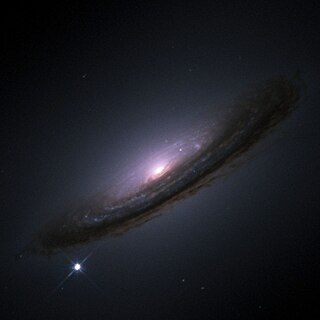
A supernova is a powerful and luminous explosion of a star. A supernova occurs during the last evolutionary stages of a massive star, or when a white dwarf is triggered into runaway nuclear fusion. The original object, called the progenitor, either collapses to a neutron star or black hole, or is completely destroyed to form a diffuse nebula. The peak optical luminosity of a supernova can be comparable to that of an entire galaxy before fading over several weeks or months.
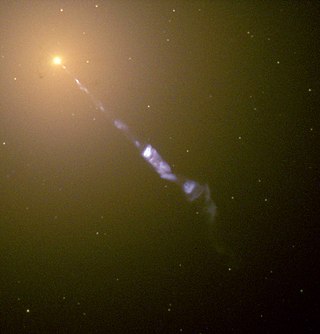
A blazar is an active galactic nucleus (AGN) with a relativistic jet directed very nearly towards an observer. Relativistic beaming of electromagnetic radiation from the jet makes blazars appear much brighter than they would be if the jet were pointed in a direction away from Earth. Blazars are powerful sources of emission across the electromagnetic spectrum and are observed to be sources of high-energy gamma ray photons. Blazars are highly variable sources, often undergoing rapid and dramatic fluctuations in brightness on short timescales. Some blazar jets appear to exhibit superluminal motion, another consequence of material in the jet traveling toward the observer at nearly the speed of light.
In astroparticle physics, an ultra-high-energy cosmic ray (UHECR) is a cosmic ray with an energy greater than 1 EeV (1018 electronvolts, approximately 0.16 joules), far beyond both the rest mass and energies typical of other cosmic ray particles.
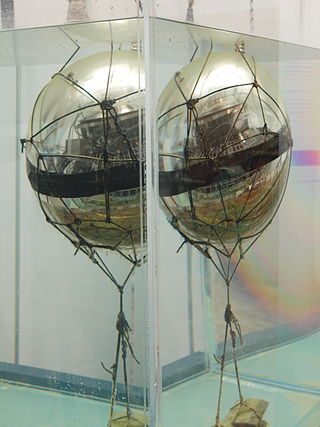
Neutrino astronomy is the branch of astronomy that gathers information about astronomical objects by observing and studying neutrinos emitted by them with the help of neutrino detectors in special Earth observatories. It is an emerging field in astroparticle physics providing insights into the high-energy and non-thermal processes in the universe.

The IceCube Neutrino Observatory is a neutrino observatory developed by the University of Wisconsin–Madison and constructed at the Amundsen–Scott South Pole Station in Antarctica. The project is a recognized CERN experiment (RE10). Its thousands of sensors are located under the Antarctic ice, distributed over a cubic kilometer.
The SuperNova Early Warning System (SNEWS) is a network of neutrino detectors designed to give early warning to astronomers in the event of a supernova in the Milky Way, our home galaxy, or in a nearby galaxy such as the Large Magellanic Cloud or the Canis Major Dwarf Galaxy.

Paolo Padovani is an Italian astronomer working at the European Southern Observatory, specializing in the study of Active galactic nuclei including the study of quasars and blazars, evolution and multifrequency studies and extragalactic backgrounds. In 2004 he and several other astronomers discovered 30 supermassive blackholes at the European Astrophysical Virtual Observatory using pioneering techniques.
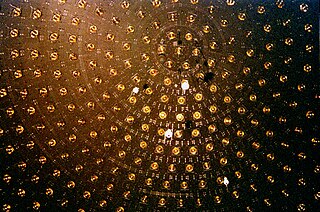
A neutrino detector is a physics apparatus which is designed to study neutrinos. Because neutrinos only weakly interact with other particles of matter, neutrino detectors must be very large to detect a significant number of neutrinos. Neutrino detectors are often built underground, to isolate the detector from cosmic rays and other background radiation. The field of neutrino astronomy is still very much in its infancy – the only confirmed extraterrestrial sources as of 2018 are the Sun and the supernova 1987A in the nearby Large Magellanic Cloud. Another likely source is the blazar TXS 0506+056 about 3.7 billion light years away. Neutrino observatories will "give astronomers fresh eyes with which to study the universe".
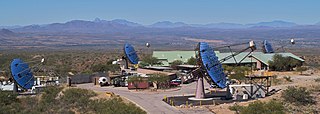
VERITAS is a major ground-based gamma-ray observatory with an array of four 12 meter optical reflectors for gamma-ray astronomy in the GeV – TeV photon energy range. VERITAS uses the Imaging Atmospheric Cherenkov Telescope technique to observe gamma rays that cause particle showers in Earth's atmosphere that are known as extensive air showers. The VERITAS array is located at the Fred Lawrence Whipple Observatory, in southern Arizona, United States. The VERITAS reflector design is similar to the earlier Whipple 10-meter gamma-ray telescope, located at the same site, but is larger in size and has a longer focal length for better control of optical aberrations. VERITAS consists of an array of imaging telescopes deployed to view atmospheric Cherenkov showers from multiple locations to give the highest sensitivity in the 100 GeV – 10 TeV band. This very high energy observatory, completed in 2007, effectively complements the Large Area Telescope (LAT) of the Fermi Gamma-ray Space Telescope due to its larger collection area as well as coverage in a higher energy band.

Extragalactic cosmic rays are very-high-energy particles that flow into the Solar System from beyond the Milky Way galaxy. While at low energies, the majority of cosmic rays originate within the Galaxy (such as from supernova remnants), at high energies the cosmic ray spectrum is dominated by these extragalactic cosmic rays. The exact energy at which the transition from galactic to extragalactic cosmic rays occurs is not clear, but it is in the range 1017 to 1018 eV.

Gravitational-wave astronomy is a subfield of astronomy concerned with the detection and study of gravitational waves emitted by astrophysical sources.
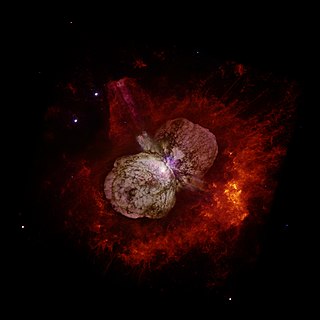
Gamma-ray burst progenitors are the types of celestial objects that can emit gamma-ray bursts (GRBs). GRBs show an extraordinary degree of diversity. They can last anywhere from a fraction of a second to many minutes. Bursts could have a single profile or oscillate wildly up and down in intensity, and their spectra are highly variable unlike other objects in space. The near complete lack of observational constraint led to a profusion of theories, including evaporating black holes, magnetic flares on white dwarfs, accretion of matter onto neutron stars, antimatter accretion, supernovae, hypernovae, and rapid extraction of rotational energy from supermassive black holes, among others.

A neutron star merger is the stellar collision of neutron stars. When two neutron stars fall into mutual orbit, they gradually spiral inward due to the loss of energy emitted as gravitational radiation. When they finally meet, their merger leads to the formation of either a more massive neutron star, or—if the mass of the remnant exceeds the Tolman–Oppenheimer–Volkoff limit—a black hole. The merger can create a magnetic field that is trillions of times stronger than that of Earth in a matter of one or two milliseconds. These events are believed to create short gamma-ray bursts.

The first direct observation of gravitational waves was made on 14 September 2015 and was announced by the LIGO and Virgo collaborations on 11 February 2016. Previously, gravitational waves had been inferred only indirectly, via their effect on the timing of pulsars in binary star systems. The waveform, detected by both LIGO observatories, matched the predictions of general relativity for a gravitational wave emanating from the inward spiral and merger of a pair of black holes of around 36 and 29 solar masses and the subsequent "ringdown" of the single resulting black hole. The signal was named GW150914. It was also the first observation of a binary black hole merger, demonstrating both the existence of binary stellar-mass black hole systems and the fact that such mergers could occur within the current age of the universe.
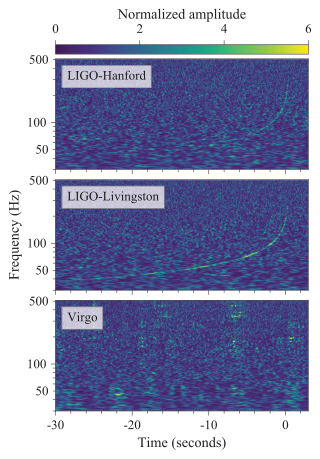
GW170817 was a gravitational wave (GW) signal observed by the LIGO and Virgo detectors on 17 August 2017, originating from the shell elliptical galaxy NGC 4993, about 140 million light years away. The signal was produced by the last moments of the inspiral process of a binary pair of neutron stars, ending with their merger. It was the first GW observation to be confirmed by non-gravitational means. Unlike the five previous GW detections—which were of merging black holes and thus not expected to produce a detectable electromagnetic signal—the aftermath of this merger was seen across the electromagnetic spectrum by 70 observatories on 7 continents and in space, marking a significant breakthrough for multi-messenger astronomy. The discovery and subsequent observations of GW170817 were given the Breakthrough of the Year award for 2017 by the journal Science.
TXS 0506+056 is a very high energy blazar – a quasar with a relativistic jet pointing directly towards Earth – of BL Lac-type. With a redshift of 0.3365 ± 0.0010, it has a luminosity distance of about 1.75 gigaparsecs. Its approximate location on the sky is off the left shoulder of the constellation Orion. Discovered as a radio source in 1983, the blazar has since been observed across the entire electromagnetic spectrum.
Supernova neutrinos are weakly interactive elementary particles produced during a core-collapse supernova explosion. A massive star collapses at the end of its life, emitting on the order of 1058 neutrinos and antineutrinos in all lepton flavors. The luminosity of different neutrino and antineutrino species are roughly the same. They carry away about 99% of the gravitational energy of the dying star as a burst lasting tens of seconds. The typical supernova neutrino energies are 10 to 20 MeV. Supernovae are considered the strongest and most frequent source of cosmic neutrinos in the MeV energy range.
Laura Maraschi is an Italian astronomer. She works for the Brera Astronomical Observatory. In 2013, she was on the organizing committee of the International Astronomical Union Symposium 304.
References
- ↑ Bartos, Imre; Kowalski, Marek (2017). Multimessenger Astronomy. IOP Publishing. Bibcode:2017muas.book.....B. doi:10.1088/978-0-7503-1369-8. ISBN 978-0-7503-1369-8.
- ↑ Franckowiak, Anna (2017). "Multimessenger Astronomy with Neutrinos". Journal of Physics: Conference Series. 888 (12009): 012009. Bibcode:2017JPhCS.888a2009F. doi: 10.1088/1742-6596/888/1/012009 .
- ↑ Branchesi, Marica (2016). "Multi-messenger astronomy: gravitational waves, neutrinos, photons, and cosmic rays". Journal of Physics: Conference Series. 718 (22004): 022004. Bibcode:2016JPhCS.718b2004B. doi: 10.1088/1742-6596/718/2/022004 .
- ↑ Abadie, J.; et al. (The LIGO Collaboration) (2012). "Implications for the origins of GRB 051103 from the LIGO observations". The Astrophysical Journal. 755 (1): 2. arXiv: 1201.4413 . Bibcode:2012ApJ...755....2A. doi:10.1088/0004-637X/755/1/2. S2CID 15494223.
- 1 2 Spurio, Maurizio (2015). Particles and Astrophysics: A Multi-Messenger Approach. Astronomy and Astrophysics Library. Springer. p. 46. doi:10.1007/978-3-319-08051-2. ISBN 978-3-319-08050-5.
- ↑ Supernova Theory Group: Core-Collapse Supernova Gravitational Wave Signature Catalog
- ↑ "No neutrino emission from a binary neutron star merger". 16 October 2017. Retrieved 20 July 2018.
- ↑ IceCube Collaboration*†; Abbasi, R.; Ackermann, M.; Adams, J.; Aguilar, J. A.; Ahlers, M.; Ahrens, M.; Alameddine, J. M.; Alispach, C.; Alves, A. A.; Amin, N. M.; Andeen, K.; Anderson, T.; Anton, G.; Argüelles, C. (2022-11-04). "Evidence for neutrino emission from the nearby active galaxy NGC 1068". Science. 378 (6619): 538–543. arXiv: 2211.09972 . Bibcode:2022Sci...378..538I. doi:10.1126/science.abg3395. hdl:1854/LU-01GSA90WVKWXWD30RYFKKK1XC6. ISSN 0036-8075. PMID 36378962. S2CID 253320297.
- ↑ Staff (3 November 2022). "IceCube neutrinos give us first glimpse into the inner depths of an active galaxy". IceCube. Retrieved 2022-11-23.
- 1 2 A tidal disruption event coincident with a high-energy neutrino (free preprint)
- ↑ Reusch, Simeon; Stein, Robert; Kowalski, Marek; van Velzen, Sjoert; Franckowiak, Anna; Lunardini, Cecilia; Murase, Kohta; Winter, Walter; Miller-Jones, James C. A.; Kasliwal, Mansi M.; Gilfanov, Marat (2022-06-03). "Candidate Tidal Disruption Event AT2019fdr Coincident with a High-Energy Neutrino". Physical Review Letters. 128 (22): 221101. arXiv: 2111.09390 . Bibcode:2022PhRvL.128v1101R. doi:10.1103/PhysRevLett.128.221101. hdl:20.500.11937/90027. PMID 35714251. S2CID 244345574.
- ↑ AMON home page
- ↑ Smith, M.W.E.; et al. (May 2013). "The Astrophysical Multimessenger Observatory Network (AMON)" (PDF). Astroparticle Physics. 45: 56–70. arXiv: 1211.5602 . Bibcode:2013APh....45...56S. doi:10.1016/j.astropartphys.2013.03.003. hdl:2060/20140006956. S2CID 55937718.
- ↑ Landau, Elizabeth; Chou, Felicia; Washington, Dewayne; Porter, Molly (16 October 2017). "NASA Missions Catch First Light from a Gravitational-Wave Event". NASA . Retrieved 17 October 2017.
- ↑ Albert, A.; et al. (ANTARES, IceCube, and the Pierre Auger Observatory) (16 Oct 2017). "Search for high-energy neutrinos from binary neutron star merger GW170817 with ANTARES, IceCube, and the Pierre Auger Observatory". The Astrophysical Journal. 850 (2): L35. arXiv: 1710.05839 . Bibcode:2017ApJ...850L..35A. doi: 10.3847/2041-8213/aa9aed . S2CID 217180814.
- ↑ Starr, Michelle (2020-10-12). "Astronomers Detect Eerie Glow Still Radiating From Neutron Star Collision Years Later". ScienceAlert. Retrieved 2023-01-04.
- ↑ Finkbeiner, A. (2017-09-22). "The New Era of Multimessenger Astronomy". Scientific American. 318 (5): 36–41. doi:10.1038/scientificamerican0518-36. PMID 29672499.
- ↑ https://gcn.gsfc.nasa.gov/gcn/gcn3/21916.gcn3 [ bare URL plain text file ]
- ↑ Cleary, D. (2018-07-12). "Ghostly particle caught in polar ice ushers in new way to look at the universe". Science. doi:10.1126/science.aau7505. S2CID 126347626.
- ↑ IceCube Collaboration (2018-07-12). "Neutrino emission from the direction of the blazar TXS 0506+056 prior to the IceCube-170922A alert". Science. 361 (6398): 147–151. arXiv: 1807.08794 . Bibcode:2018Sci...361..147I. doi:10.1126/science.aat2890. PMID 30002248. S2CID 133261745.
- ↑ "ATel #10791: Fermi-LAT detection of increased gamma-ray activity of TXS 0506+056, located inside the IceCube-170922A error region".
- ↑ Mirzoyan, Razmik (2017-10-04). "ATel #10817: First-time detection of VHE gamma rays by MAGIC from a direction consistent with the recent EHE neutrino event IceCube-170922A". Astronomerstelegram.org. Retrieved 2018-07-16.
- 1 2 Aartsen; et al. (The IceCube Collaboration, Fermi-LAT, MAGIC, AGILE, ASAS-SN, HAWC, H.E.S.S., INTEGRAL, Kanata, Kiso, Kapteyn, Liverpool Telescope, Subaru, Swift/NuSTAR, VERITAS, VLA/17B-403 teams) (12 July 2018). "Multimessenger observations of a flaring blazar coincident with high-energy neutrino IceCube-170922A". Science . 361 (6398): eaat1378. arXiv: 1807.08816 . Bibcode:2018Sci...361.1378I. doi:10.1126/science.aat1378. PMID 30002226. S2CID 49734791.
- ↑ De Angelis, Alessandro; Pimenta, Mario (2018). Introduction to particle and astroparticle physics (multimessenger astronomy and its particle physics foundations). Springer. doi:10.1007/978-3-319-78181-5. ISBN 978-3-319-78181-5.
- ↑ Aartsen; et al. (IceCube Collaboration) (12 July 2018). "Neutrino emission from the direction of the blazar TXS 0506+056 prior to the IceCube-170922A alert". Science. 361 (6398): 147–151. arXiv: 1807.08794 . Bibcode:2018Sci...361..147I. doi:10.1126/science.aat2890. PMID 30002248. S2CID 133261745.
- ↑ Overbye, Dennis (July 12, 2018). "It Came From a Black Hole, and Landed in Antarctica - For the first time, astronomers followed cosmic neutrinos into the fire-spitting heart of a supermassive blazar". The New York Times . Retrieved July 13, 2018.
- ↑ "Neutrino that struck Antarctica traced to galaxy 3.7bn light years away". The Guardian. July 12, 2018. Retrieved July 12, 2018.
- ↑ "Source of cosmic 'ghost' particle revealed". BBC. July 12, 2018. Retrieved 12 July 2018.
- ↑ Buchanan, Mark (2022-06-03). "Neutrinos from a Black Hole Snack". Physics. 15: 77. Bibcode:2022PhyOJ..15...77B. doi: 10.1103/Physics.15.77 . S2CID 251078776.
- ↑ Wright, Katherine (2023). "Milky Way Viewed through Neutrinos". Physics. 16. Physics 16, 115 (29 June 2023): 115. Bibcode:2023PhyOJ..16..115W. doi: 10.1103/Physics.16.115 .
Kurahashi Neilson first came up with the idea to use cascade neutrinos to map the Milky Way in 2015.
- ↑ Chang, Kenneth (29 June 2023). "Neutrinos Build a Ghostly Map of the Milky Way - Astronomers for the first time detected neutrinos that originated within our local galaxy using a new technique". The New York Times . Archived from the original on 29 June 2023. Retrieved 30 June 2023.
- ↑ IceCube Collaboration (29 June 2023). "Observation of high-energy neutrinos from the Galactic plane". Science. 380 (6652): 1338–1343. arXiv: 2307.04427 . doi:10.1126/science.adc9818. PMID 37384687. Archived from the original on 30 June 2023. Retrieved 30 June 2023.